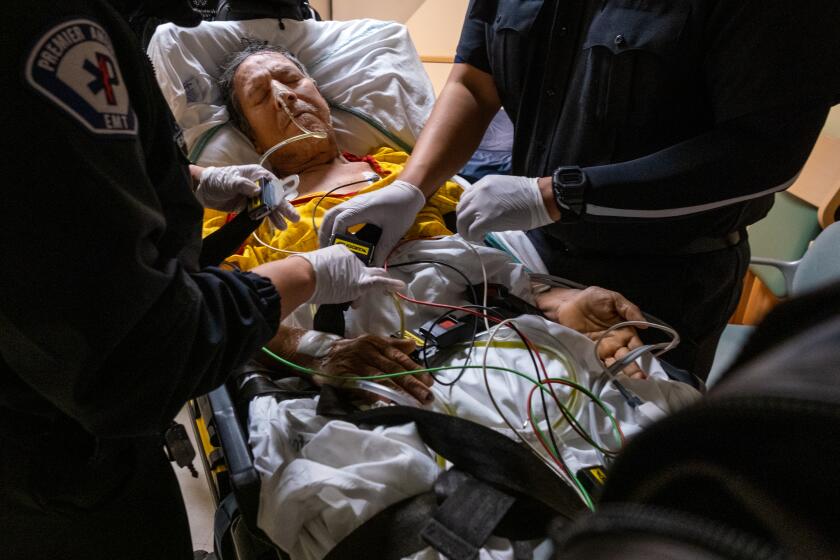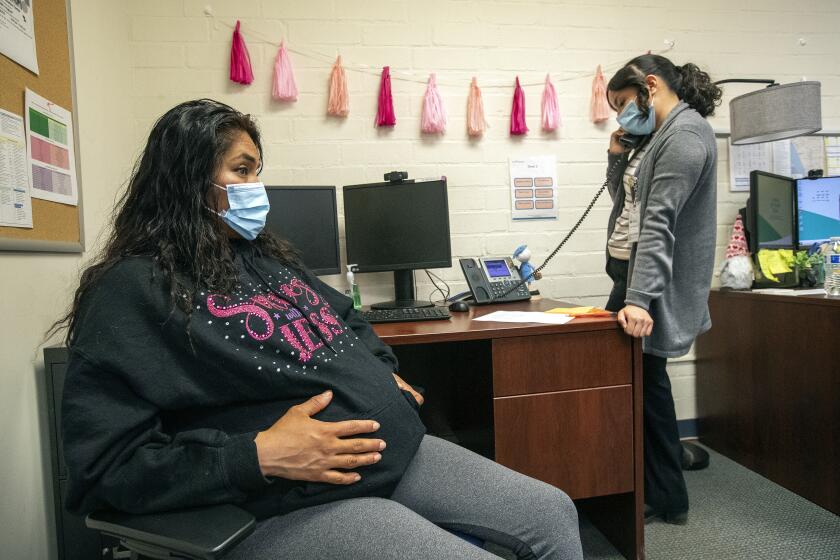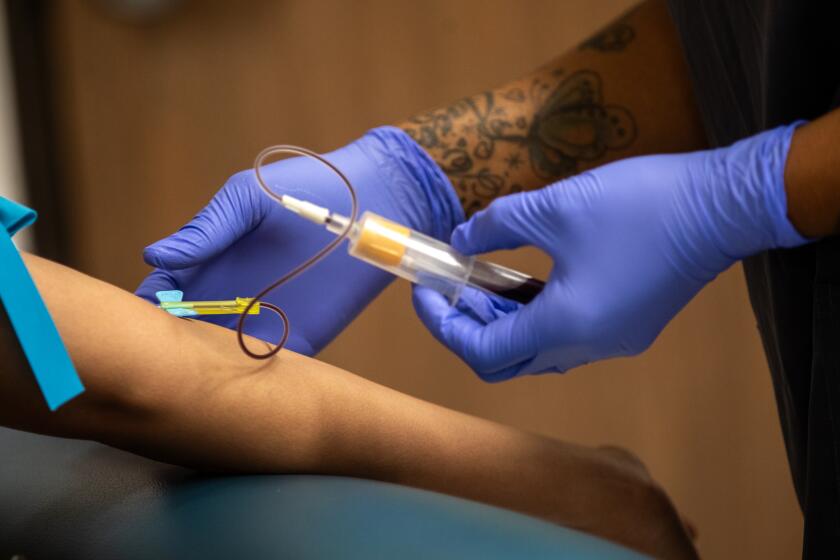Californians who need help paying for ’round-the-clock home care are stuck on a state waitlist
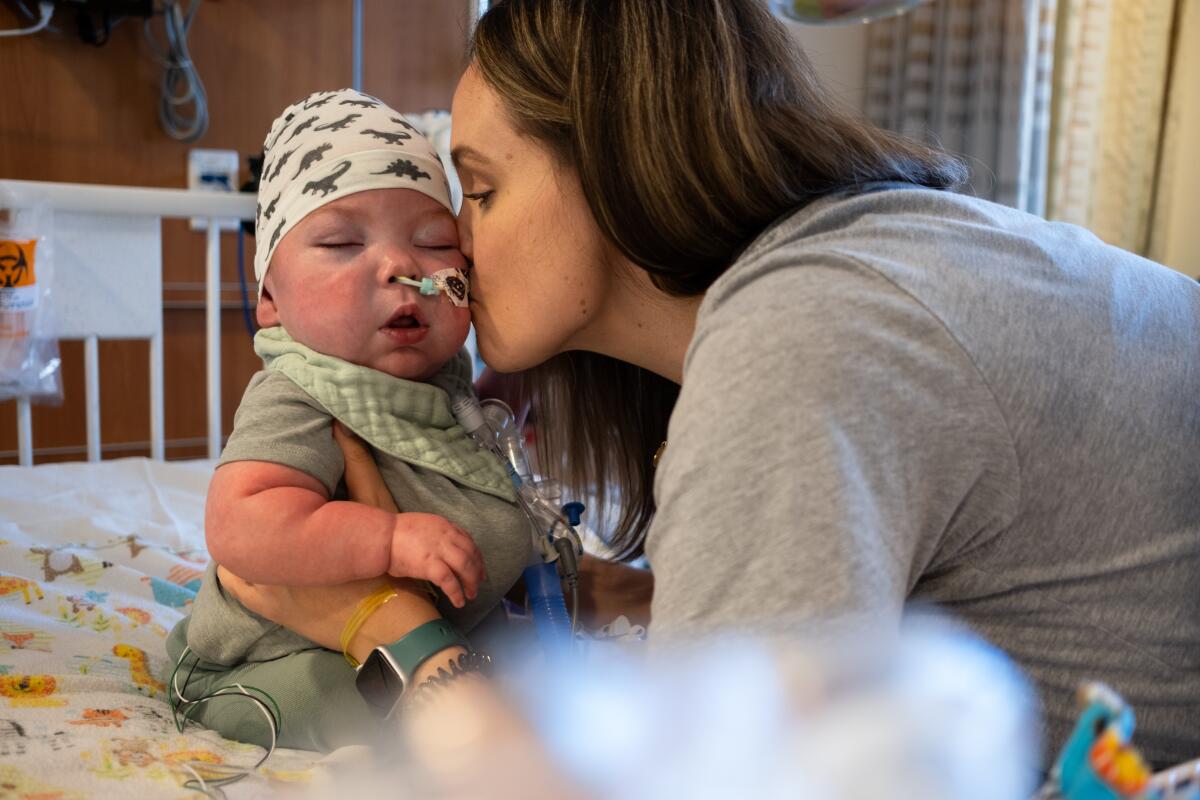
- Share via
Nine months after giving birth, Caitlin Martin is still waiting to bring her son home from the hospital.
Her son Connor uses a feeding tube and relies on a tracheostomy and a ventilator to breathe. He was born with a rare birth defect called an omphalocele, which means some of his organs sit in a sac outside his body. Surgeons will eventually fix it, but only after a few years when he has grown bigger.
Martin, who has been coming every day to the neonatal intensive care unit at Children’s Hospital of Orange County to help care for Connor, is eager to bring him home to Anaheim.
But she also fears there will be scant help for her and her husband when that happens, driving them to exhaustion and possibly putting Connor at risk.
Their health insurance will only cover so many hours of nursing care at home — time that could run out within weeks with a child needing ‘round-the-clock care.
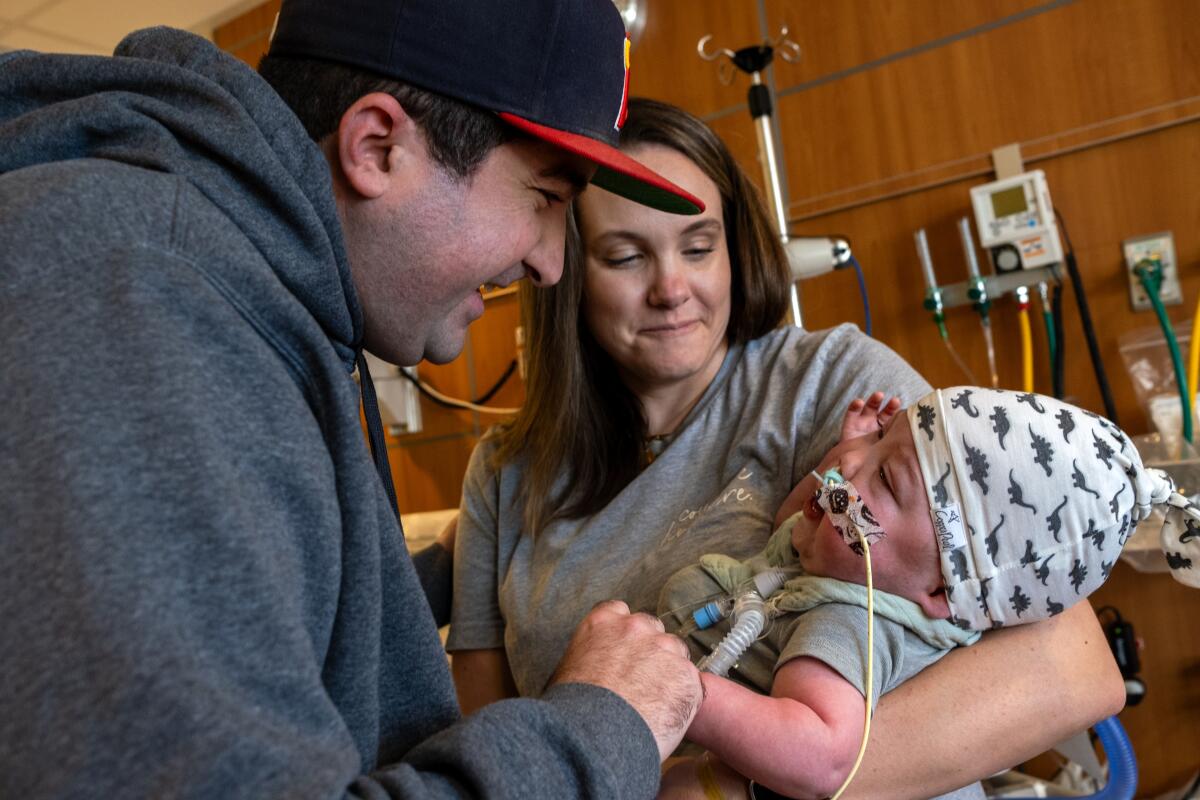
Families like hers can get Medicaid benefits for services that allow medically fragile people to live at home instead of in a hospital, nursing facility or other institution. In California, they can do so by obtaining the Home and Community-Based Alternatives waiver.
But Connor and thousands of other Californians have been languishing on a waitlist. The state stopped accepting applications for the program over the summer, saying it was hitting its annual allotment of 8,974 spots. The cutoff has stranded people who have no realistic way to pay for all the home nursing their families need.
The danger is that “parents are going to decide, ‘We want to bring our child home. We’re going to go home with the limited coverage we have through our commercial plan even though our child needs 24-7 care. We’re just going to not sleep to make sure someone’s awake to care for the child,’” said Anna Leach-Proffer, managing attorney for Disability Rights California. “That puts the child at risk.”
As of September, more than 3,000 state residents were waiting for an HCBA waiver. Some have been stuck in hospitals or nursing facilities, advocates say. Other families have cobbled together enough care at home for their loved ones but can end up dangerously exhausted or financially strained.
Delays in transfers can put people at higher risk of complications and derail day-to-day life for patients.
In Clovis, Sarah Scharnick has gone on leave and relied on family and friends to help her care for her husband, James, who suffered a crash while mountain biking and now needs 24-hour care, including being turned every two hours to prevent bedsores. “It takes two people because he’s a big guy,” Scharnick said. “My mom stays. Our friends have made a little schedule. ... It’s taking a village.”
Their insurance pays for James to get medical care at home for a wound he got while in intensive care, but that’s only a handful of hours a week, not “any of the day-to-day stuff,” Sarah Scharnick said. She worries about what will happen when she has to go back to work as a speech therapist.
If she has to pay out of pocket for nursing care, “there’s no way I can afford it.” Private insurance does not typically cover anywhere near the amount of nursing care that someone may need at home, advocates said. As for a nursing facility, Scharnick said, “we just don’t want that. It’s not where he needs to be.”
Martin is a registered nurse and plans to put her career on hold to handle much of her son’s care at home, but her husband works during the day, and “we have to sleep at some point,” she said. She fears Connor could disconnect his ventilator without anyone realizing it because the tracheostomy prevents his cries from being heard.
“Somebody has to be awake with him,” she said. “In my nursing brain, it’s a safety concern.”
Martin is infuriated by the fact that Medi-Cal, the state’s Medicaid program, will readily pay for baby Connor to be in a nursing facility, but not at “home where we know he’s going to thrive best and is actually the least costly for the state.”
“It’s just crazy to me that that’s how broken our system is,” she said.
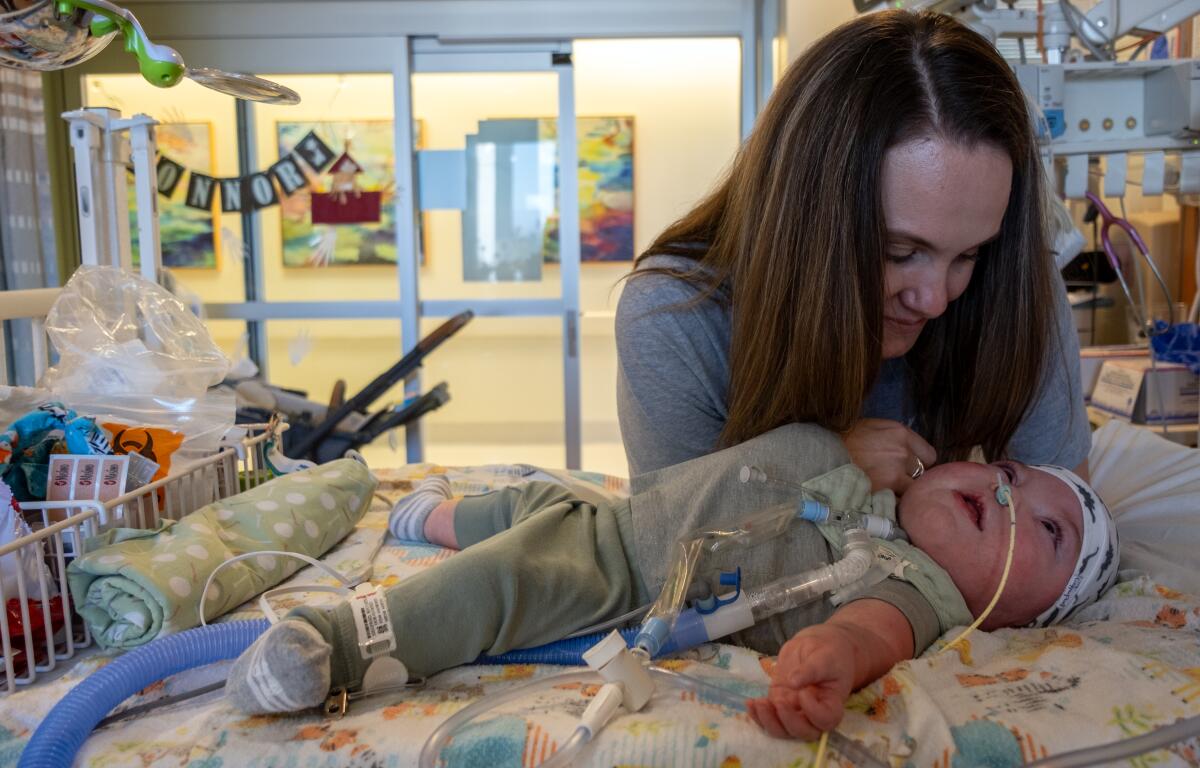
Children like Connor, whose families make too much to qualify for Medi-Cal, are eligible for the program when they live in nursing facilities or institutions because in those situations, parental income isn’t taken into account. At home, however, they can lose that eligibility unless they get the HCBA waiver (or other Medi-Cal waivers for people with developmental disabilities).
For eligible adults with serious disabilities or injuries, Medi-Cal covers a nursing home if a physician authorizes it but will not cover the same level of care at home without a waiver.
Tens of thousands of L.A. households have had Medi-Cal discontinued this month. Across the U.S., over 3 million had lost Medicaid coverage as of Wednesday.
The California Department of Health Care Services told local agencies in July that it was no longer accepting new applications because the program was hitting its annual cap on participants. “It was kind of a shock,” said Pauline Shatara, deputy director of California Advocates for Nursing Home Reform.
The state said it was planning to ask the federal government for more slots that would become available in January, though it was still determining how many.
However, “even when they do add more slots, it feels like they’re playing catch-up,” Shatara said.
Advocates believe even more people are probably in need of the program but have been unaware of its existence or discouraged from trying to apply. The HCBA waiting list was long for so many years that “people stopped considering it a viable option,” said Elizabeth Zirker, senior counsel with Disability Rights California.
Disability Rights California has called for 50,000 slots in the state, with the ability to add more if needed. Shorting the program will result in “unnecessary institutionalization of thousands of Californians,” it said.
The organization also noted that the average cost for someone with an HCBA waiver is less than $48,000 annually, compared with nearly $129,000 annually for the same kinds of patients in a skilled nursing facility, according to estimates from the California Department of Health Care Services.
The California program and others like it can be traced back to the 1980s, when an Iowa family complained that their young daughter with partial paralysis had to remain hospitalized in order for her daily care to be covered by Medicaid, even though she could have been cared for at home at lower cost.
The story moved President Reagan, propelling the federal government to allow states to waive some Medicaid requirements so that people could get services in their homes instead of institutions.
But the waivers “did not do anything to change what is mandatory to fund under the federal law and what is optional,” said Nicole Jorwic, chief of advocacy and campaigns for the nonprofit Caring Across Generations. Because the waivers were created as an optional service, “it can be capped,” and Jorwic said that whenever budgets are tight, “the first thing that gets cut are the optional services.”
The AIDS Healthcare Foundation has been resisting a push from L.A. County to ask people if they have insurance that can cover costs for STD tests.
California officials said they have to show the federal government that the waiver is “cost-neutral,” with average spending per patient no higher than for institutional care for the same kinds of patients.
When the state sought federal approval for the latest round of the program, it said participation would be capped at just under 9,000 people at a time for two years, with annual increases in the following three years to reach roughly 12,300.
Disability rights and caregiving advocates also stress that most people prefer to be cared for at home. The Supreme Court ruled decades ago that unnecessarily institutionalizing people who can be served in their communities violates the Americans With Disabilities Act.
The problem is that “we have an institutional bias in our healthcare spending,” said Jennifer McLelland, an advocate with Little Lobbyists, which represents the needs of medically complex children. “The state will pay for costly institutional care automatically — but it only pays for cost-effective home care as an optional service. That’s the opposite of what we should be doing.”
The state will pay for costly institutional care automatically — but it only pays for cost-effective home care as an optional service. That’s the opposite of what we should be doing.
— Jennifer McLelland, an advocate with Little Lobbyists
Many states have had waitlists to access services that allow people to remain in their homes and communities, leaving hundreds of thousands of people across the country in limbo, according to a KFF analysis.
In California, the last time the HCBA waiver program hit its annual cap was six years ago, according to the state’s Department of Health Care Services. The agency said it believes there was a boost in applicants this year due to increased outreach by local agencies, broader awareness of the program and its benefits, and more interest in home-based care as a result of the COVID-19 pandemic.
COVID “changed the dynamics,” both because of infection concerns and because family members were newly able to work from home, said Jonathan Istrin, executive director of the home care agency Libertana, one of the agencies that helps people apply for the waiver program. “People had always had eligibility, but now we had all these people who didn’t want to be in a nursing home.”
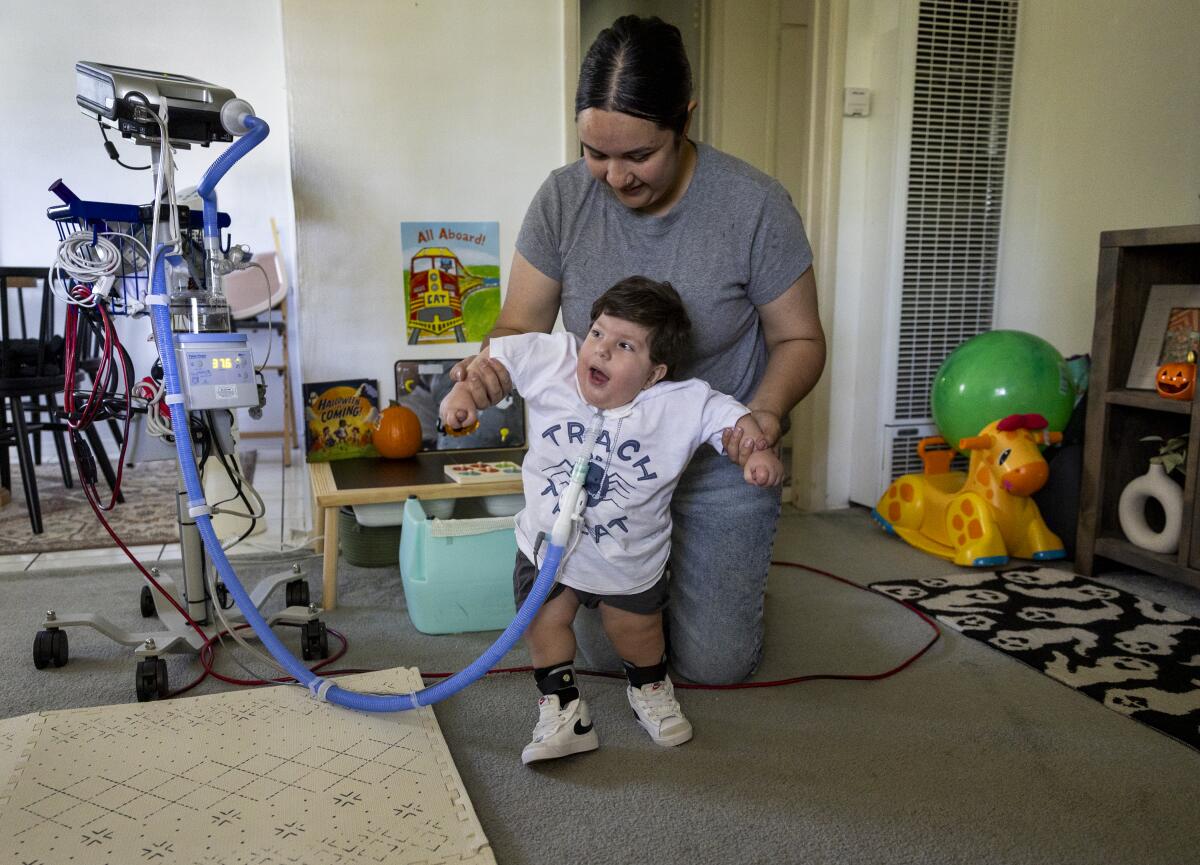
Lack of access to the program can have reverberating impacts for families. In Baldwin Park, it is costing the family of 2-year-old Gideon Chavez in multiple ways.
Gideon was born with a heart defect and uses a ventilator and a feeding tube, requiring ‘round-the-clock care. His mother, Jessica Gonzalez, applied for an HCBA waiver, and if it had come through, Gideon would have been able to keep the Medi-Cal coverage he lost at the end of September due to his family’s income.
When Gideon was on Medi-Cal, he was also eligible for a state program that paid Gonzalez almost $5,000 a month to serve as his home caregiver. Medi-Cal also could pay for equipment to help Gideon walk, something their private insurance does not cover, Gonzalez said.
With less income and higher out-of-pocket medical costs for Gideon, the family is now facing “an extra level of stress,” she said.
“I always find it baffling how parents that have kids with disabilities or that are medically fragile, just how much we have to go through in order to apply for something,” she said. Things are hard already, “and I feel like the state makes it extra hard.”
More to Read
Sign up for Essential California
The most important California stories and recommendations in your inbox every morning.
You may occasionally receive promotional content from the Los Angeles Times.
